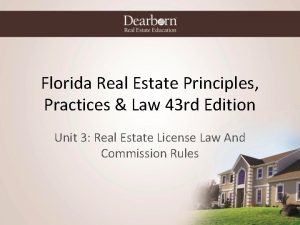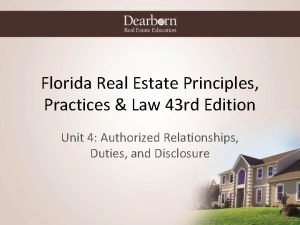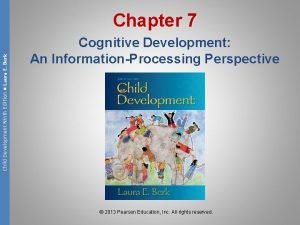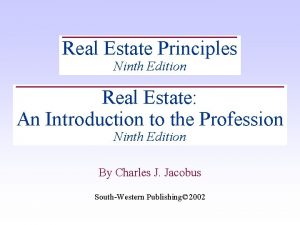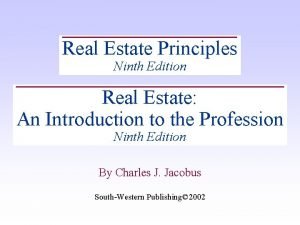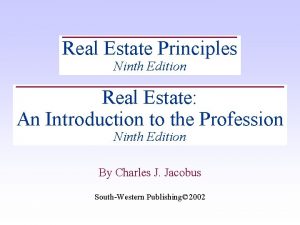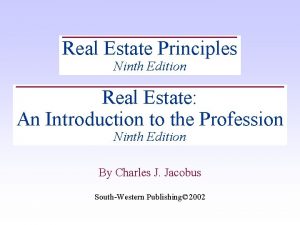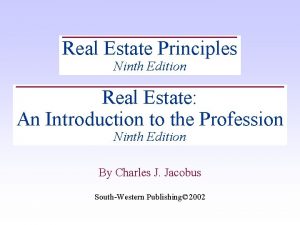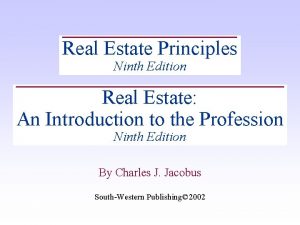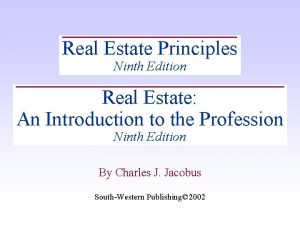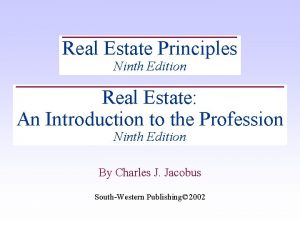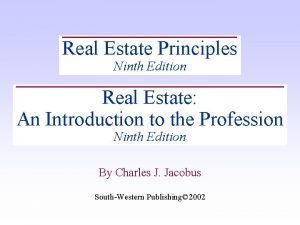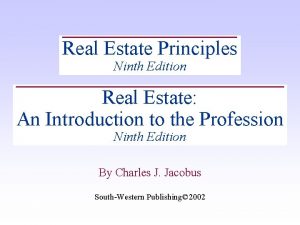Real Estate Principles Ninth Edition Real Estate An











- Slides: 11

Real Estate Principles Ninth Edition Real Estate: An Introduction to the Profession Ninth Edition By Charles J. Jacobus South-Western Publishing© 2002

Chapter 27 ____________________ Investing in Real Estate South-Western Publishing© 2002

Investing • Appreciation – increase in property value over time. • Mortgage reduction – the decline of the mortgage balance as payments are made. • Cash flow – money left each year after paying property operating expenses and debt service. • Tax shelter – tax deductible expenses generated by an investment property. South-Western Publishing© 2002

Cash Flow Projection Rent receipts for the year $30, 500 Less operating expenses $10, 000 Less mortgage loan payments $20, 000 Equals cash flow $ 500 South-Western Publishing© 2002

Taxable Loss Rent receipts for the year Less operating expenses Less interest on loan $19, 500 Less Depreciation Equals taxable income 8, 000 $30, 000 $10, 000 $ ($ 7, 000)* *In accounting language, parentheses indicate a negative or minu South-Western Publishing© 2002

Calculating Equity Build-up Equity at Time of Purchase Later Purchase price $200, 000 $220, 000 Mortgage -140, 000 (equity)loan -120, 000 Down payment $ 60, 000 equity $100, 000 Equity 5 Years Market value Less loan balance Equals current Equity Build-Up current equity $100, 000 less beginning equity -60, 000 South-Western Publishing© 2002 equals equity build-up $ 40, 000

Leverage • The ability to use borrowed funds to purchase investment property. Purchase Price Cash Down Loan Leverage $100, 000 $20, 000 $80, 000 80% • Investor only needs $20, 000 to control $100, 000 property or 20¢ cash for each $1 of cost. South-Western Publishing© 2002

GLITAMAD G= the. Lrisk = I = return T = A= least M= A= D= risk, return Ground (the raw land stage) Increasing Loan (long-term loan commitment) increasing Interim (short-term loan, construction) Least risk, Tenancy (building filled with tenants) Absorption (second through tenth year) Maturity (eleventh through thirtieth year) Aging (more than 30 years) Demise (demolition, reuse of the land) return Increasing increasing As the risk that an investor will suffer a loss increases, the expected returns must increase. South-Western Publishing© 2002

Lifetime Income and Consumption Patterns South-Western Publishing© 2002

Comparative Appraisal and Investment Objectives APPRAISER’S VIEWPOINT INVESTOR’S VIEWPOINT Value =Net Income Return =Net Income Price The appraiser solves for value. The investor solves for return. South-Western Publishing© 2002

Key Terms • • • Cash Flow Cash-on-cash Downside risk Equity build-up Investment strategy • • Leverage Negative cash flow Prospectus Straight-line depreciation • Tax shelter South-Western Publishing© 2002
 Involuntary inactive real estate license florida
Involuntary inactive real estate license florida Florida real estate principles practices
Florida real estate principles practices Levels of analysis psychology
Levels of analysis psychology Mankiw macroeconomics 9th edition
Mankiw macroeconomics 9th edition Human anatomy & physiology edition 9
Human anatomy & physiology edition 9 Psychology ninth edition david g myers
Psychology ninth edition david g myers Social psychology ninth edition
Social psychology ninth edition Biology ninth edition
Biology ninth edition Laura e berk child development (9th edition pdf)
Laura e berk child development (9th edition pdf) Berk 2013 child development
Berk 2013 child development Abnormal psychology ronald j comer 9th edition
Abnormal psychology ronald j comer 9th edition Psychology ninth edition in modules
Psychology ninth edition in modules
